Heating a house with wood is now mainly seen as a forced measure when there are no other energy sources. Why? Such heating is troublesome, heavy, takes time and effort. With the modern rhythm of life, such expenses are a great luxury, or lost money.
If the house has an ordinary small boiler or a stove, then in fact you need to work at home as a stoker, preparing and throwing timber every 3-4 hours.
Although firewood is cheap, it simply becomes unprofitable. Also, for many people, wood materials are not acceptable because heating maintenance and living becomes uncomfortable. But how to be? How to replace timber, how to simplify the process? Is it worth it to use organic matter for heating a house at all?
wood heating cost
Heating a house with wood is evaluated in different ways. Somewhere in a wooded area, you can generally harvest the forest yourself, as in epic times. And in industrial areas, good dry logs from birch, aspen, pine are no longer cheap - about 4 rubles per kilogram, or 4,000 rubles per ton, or 2,000 rubles per cubic meter.Taking into account the efficiency of a wood-fired boiler of 70% (and this is if the heat exchanger is regularly cleaned of soot), then for a year for heating small house a decent amount of money will be spent by the forest - 36,000 rubles (we take typical heat losses per season for a small house of 25,000 kW).
How much lumber is needed
If you plan to get 25,000 kW of energy to heat a small house in one season, then you need to prepare 18 meters of cubic firewood, or 9.0 tons. (25000 / 0.7 / 4 \u003d 9.0 tons, / 0.5 (density) \u003d 18 m3).It is necessary not only to buy, but also to drag, put under a canopy or in a shed, bring it to the boiler for drying, throw it up, clean it, take out the ashes several times a day. And perhaps even chop?
What to buy
An important point. Dry firewood with a moisture content of no more than 20% was considered here. The calorific value of such material is not less than 4 kW per kilogram. But if the humidity is increased (freshly cut wood), then their calorific value drops sharply. At a humidity of 50%, - actually 2 times, 2.2 kW per kilogram of material.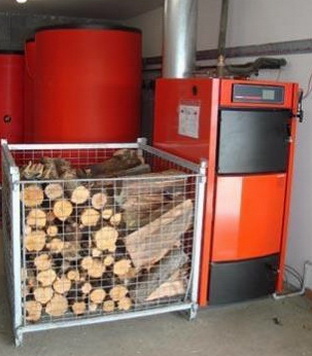
Consequently, it will take 2 times more firewood, as well as labor, to burn them.
When buying wood, you should check their moisture content with a device, point out the discrepancy to the seller, demand a discount, look for a suitable product. The quality of firewood is mainly determined not by the type of wood, since the calorific value of different varieties is approximately the same, the difference is within 10%, but by their humidity.
Furnace process
Firewood is accompanied by a lot of dust, chips, debris, and this must be constantly cleaned and cleaned. Near the boiler, in the room, several woodpile is usually stored, with a margin of at least 2 weeks, so that they would additionally dry out for 14 days in a dry, warm room before entering the furnace.During the combustion process, a lot of ash is formed - a bucket from a cubic meter. Ash is a fertilizer, and it is taken out to the site. It is necessary to monitor the amount of ash put into the ground, since exceeding the norms leads to leaching of the soil.
Cleaning the boiler should be done regularly, the frequency depends on the design itself and the type of firewood. But if you do not want the efficiency of the boiler to fall to 50%, if you want to maintain it at the level of 80 - 85%, you need to clean the heat exchanger from soot with enviable regularity.
An uninterruptible power supply to the circulation pump must be installed. In the event of a power outage, a heated wood-burning boiler will boil very quickly, which will lead to an accident. The circulation pump must run continuously.
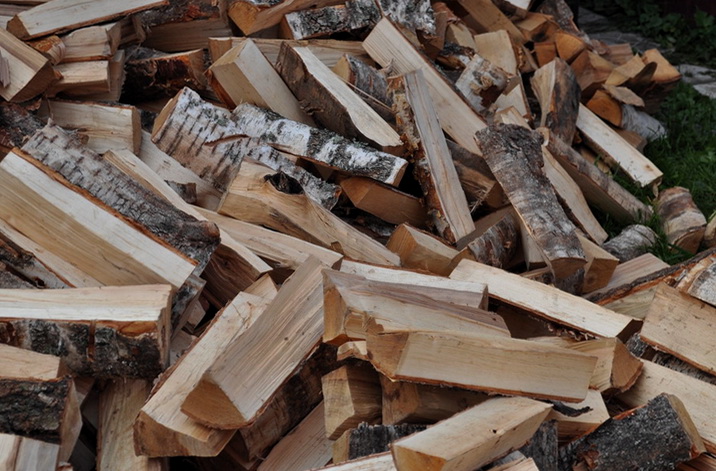
How to make burning wood easier
Simplifying the process means throwing firewood less often, and using whole logs rather than chopped ones for the firebox. This is a level to increase the comfort of servicing the boiler. But in order to heat the house in this way, a special boiler is also needed - with a large combustion chamber.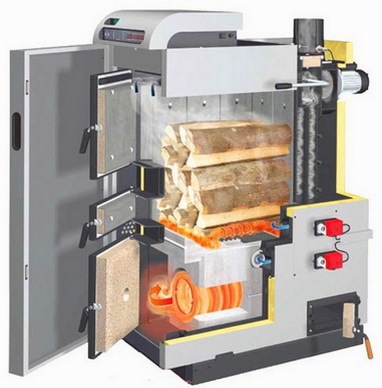
It is also possible with forced air purge, the so-called. pyrolysis boiler. These boilers are expensive, automated, forced air, dependent entirely on electricity. They need a backup generator.
But you can not throw away a lot of money for “it’s not entirely clear why”, but purchase a modern Western-made boiler, special, with the largest combustion chamber. Such a boiler seems to be the best option in terms of price and ease of use, i.e. it will be possible to simplify life with the forest by making the service more rare, while not overpaying initially. To acquire a small and cheap one means only to be imbued with the desire to replace it as quickly as possible with something more worthwhile.
A few words about pyrolysis boilers
Manufacturers are now bullying buyers by hanging on the so-called pyrolysis boilers a label with unprecedented efficiency, however, not forgetting to prescribe next to it the price is 3-5 times more compared to a conventional boiler. But the truth is somewhere in the middle.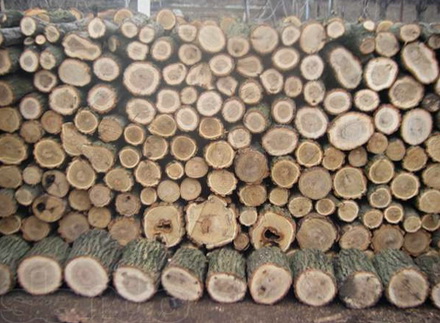
It is more correct to call such boilers blown, since pyrolysis must go with a lack of oxygen, but here, on the contrary, there is a blow. Another unpleasant fact is the blowing of ash with an air stream into the sky.
Those. there is practically nothing to take out of such a boiler, soot itself descends into the adjacent territory. Some say that ash simply does not form, but this is not true, since ash content is a characteristic of the material, and its amount does not depend on how it is burned. There are many other tales about these cauldrons that should not be believed.
For heating a private house located far from the central highways, the most effective use of the so-called alternative sources heating. Today they include wood boilers heating. Combining this type of heating with a water circuit increases its efficiency several times.
Modern technologies have not bypassed the heating industry of private houses. Therefore, a modern wood-burning boiler is not just a stove with a damper, although it works on the same principle as before. Such systems have undergone functional changes and significantly increased their efficiency.
The principle of operation of wood heating
Briefly describe the principle of operation of a boiler with a water circuit as follows:
- When burning wood in combustion chamber the heat carrier (most often water) is heated, which is located in the boiler heat exchanger.
- The heat exchanger is connected to a closed water circuit of the house, which is ordinary iron or more modern plastic or metal-plastic pipes.
- Radiators - iron or cast iron - are connected to the pipes, due to which the private house is heated.
- Having given off heat, the water from the water circuit system returns to the boiler heat exchanger, heats up again and the cycle repeats.
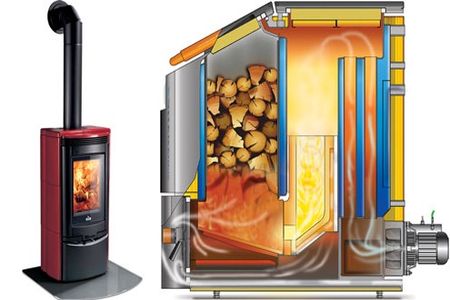
The coolant can be circulated through the system in two ways:
- Natural circulation implies complete autonomy of the entire heating system. The movement of water occurs by gravity and is achieved due to the temperature difference at the inlet-outlet, and the correct slope of the pipes.
- Forced circulation implies the presence of a pump in the system, which drives the coolant.
Advice! The arrangement of a gravity water circuit is quite difficult in practical implementation and requires certain skills and knowledge. A technically simpler option is forced circulation.
Pros and cons of wood heating
The advantages include:
- Quite low cost of equipment compared to other types of boilers.
- Simple installation and further operation that does not require special permits and approvals.
- Availability of raw materials for heating. In some regions of the country, wood is much cheaper than other energy sources.
- System autonomy.
- An environmentally cleaner way to generate thermal energy than by burning gas or oil products.
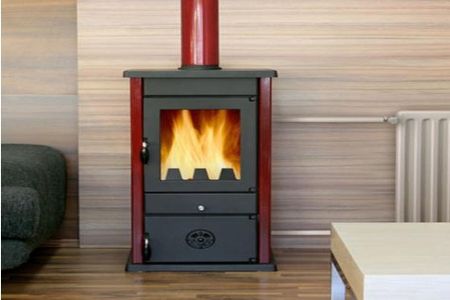
But a wood-burning heating boiler is not without drawbacks, among which it should be noted:
- The operation of such a boiler must be controlled by periodically adding fuel. This does not allow you to be away from home for a long time.
- Since the boilers are made of cast iron, they have a significant weight, which must be taken into account when choosing an installation site.
- Lack of automation supporting or controlling the combustion process or the desired temperature of the coolant.
- Despite all the innovative solutions, the efficiency of such a boiler is below 80%.
Advice! It should be remembered that a wood-burning boiler consumes a lot of fuel. Therefore, it is necessary to think over in advance a suitable place for storing firewood, for example, to build a woodshed.
Hybrid boilers
In order to somehow level out the shortcomings, many manufacturers offer hybrid heating sources for a private house. We will consider one of the most common - electric wood heating boilers.
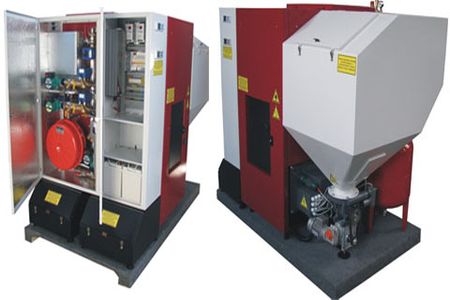
Device Features
- The design of such boilers provides for the installation of a water heating element in the boiler heat exchanger - a heating element, the power of which can be selected upon purchase or then changed to a more productive one (but not more than 6 - 7 kW).
- In most models, the electrical unit has a power regulator that allows you to adjust the temperature of the coolant.
- The furnace has not undergone any special changes and is designed for the most productive combustion of wood in it.
- The boiler is equipped with threaded pipes for the simplest possible connection with the water circuit of the house. Such boilers are capable of heating quite large areas - up to 250 m².
- The heat exchanger is located around the entire perimeter of the fuel combustion chamber. Such "ringing" with a water circuit allows the coolant to warm up as efficiently as possible in a minimum time.
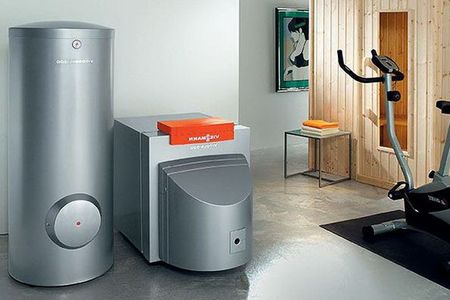
Benefits of hybrid units
- In the event of a power outage, the boiler quickly switches to wood burning mode. This will allow you to wait for the completion of the repair of electrical networks with comfort.
- Heat loss when using electricity can be significantly reduced by closing the chimney with a special damper.
- The surface of the heating unit does not heat up above 85 C°, which allows us to talk about its fire safety.
- The ease of installation and configuration of such systems is greatly facilitated by detailed instructions, specially designed by the manufacturer for self-assembly of the heating unit.
For remote villages where there is no centralized gas pipeline, the use of wood-burning or hybrid boilers with a water circuit becomes a worthy alternative. A wide selection of models that differ in power and heated area will allow you to optimally select the required unit.
When the question arose of how to heat your home, there are several options to consider. The first is to use the main gas supply, i.e., as a standard, connect to the network and use gas. When this is not possible, the choice falls on stoves and boilers that run on electricity. I would like to note that to use electrical devices very expensive for heating, so do not believe the managers in the special. stores that they are super economical and 200% useful. Due to this heating a private house with wood is still relevant.
A good option is boilers and stoves that allow you to heat private house firewood. This is the oldest way to heat a room, but it is constantly being improved. As a result, at the moment, commercially available as domestic boilers, and foreign production, most of all from Europe. And it will help you chop wood.
Let's take a closer look at the advantages and disadvantages of this type. private house heating.
Advantages of heating a private house with wood
Heating a private house with wood
Let's move on to the advantages of this heating method and also describe each in more detail.
You will not find a more environmentally friendly and natural fuel than firewood. They are not harmful, they are well kindled. The smoke that comes out of the chimney after burning wood does not affect the environment in a negative way;
Even if you refuse boilers, etc., and decide to build a full-fledged wood-burning stove, it will be easier and faster than installing a heating system. There is no point in even comparing the price of one and the other, the benefit is obvious;
As you can see, heating with wood, of course, has several “pitfalls”, but there is nothing ideal in this world.
How to heat the stove with wood?
In order to effectively use firewood as private house heating, you must execute the following pool of simple rules:
Maintain equipment in working order, supply only dry firewood so that condensation does not form;
If there is at least some crack in the frame of the valve (from 2 mm), then this is already a ten percent loss of heat and penetration of more than 15 cubic meters of air, and if combustion occurs with the door open, then even more heat will go away - up to 40% . An open blower will increase this figure by another 20%;
The stove must be kept clean, so it is very important to clean it from ash and soot in time. It is recommended to clean and repair the stove every year.
Firewood for the fireplace
The heat that is released when wood is burned in a fireplace has a different quantitative ratio for different breeds wood. Even if the absolute humidity is the same, the thermal capacity will differ anyway. .
Installation of a chimney, installation of a heating boiler, installation of automatic boiler control Boiler wood heating
The reality of the central and northern strip of Russia is such that in winter any dwelling must be equipped with heating. If with apartment buildings everything is clear, there the company is engaged in heating, which supplies the heated energy carrier to the apartment for a certain fee of money. Private cottages do not have such a heating system; accordingly, it must be installed. But under the word "installation" a multi-stage process is hidden, each stage of which requires an individual approach.
Let's start right away with a discussion of the second method - IR heaters. The system is very inefficient. It is based on the ability of infrared rays to heat any kind of surface, including the human body. Roughly speaking, the sun is simulated in your house. Everything would be fine if it were not for the price of the installations themselves, which are most often domestic market provided by Chinese manufacturers. It is not worth talking about their quality and duration of work at all. There are, of course, European and Asian (not Chinese) production, but their cost is prohibitive, and due to high electricity tariffs, the entire system will pay off in 20 years, when it will be necessary to change the installations themselves. In addition, such a heating system loses any autonomy and is entirely dependent on the supply of electricity, which is turned off every now and then in remote areas. In addition, IR heaters have low efficiency.
The third way is inherently very good. Its basis is to take heat from the "earth" and give it to the house. Both a reservoir and an underground lake can protrude underground, and, of course, the soil itself under your feet. But even with this method, not everything is so smooth. Firstly, all the necessary equipment is produced abroad and is expensive even for people of average income. Secondly, the payback comes in almost 5-10 years, depending on the installations. However, the paradox is that when, it would seem, the thermal heating system paid off, the time comes for the first planned Maintenance(TO), the cost of which is almost equal to the original price of the equipment itself, and new units, of course, according to the laws of the market and inflation, are already much more expensive. Thus, the owner of the house finds himself in an unenviable position, the only way out of which is to pay decent money, or to radically change the entire heating system, which, in fact, is the same thing.
Exclusive!!!
Installing a wood burning boiler under the stairs.
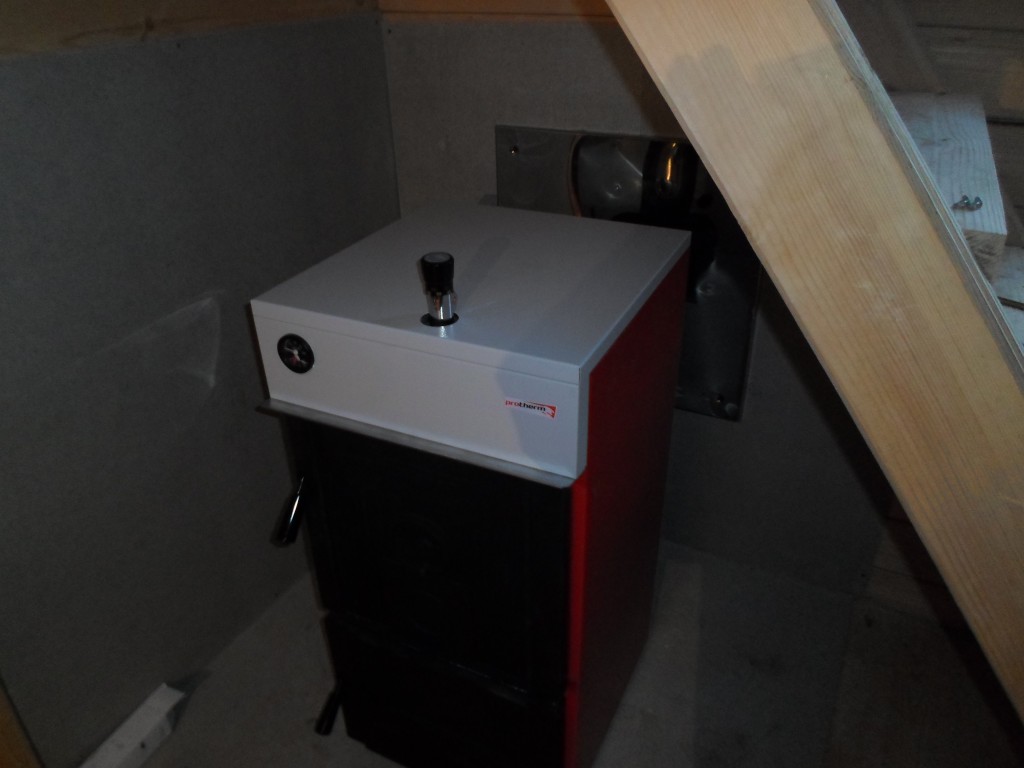
The remaining two heating methods are by far the most common in Russia. Heating of a private house in most cases is based on the principle of the convection method, or in a simple way - heating is carried out through air masses. Those. the basis of the system is a boiler that heats water or antifreeze - a coolant, which, in turn, moving through the pipes, gives thermal energy into the dwelling through the radiators.
The stove also heats the air around it, but does not have radiators and coolant. It in itself is like a large battery that warms up, absorbing heat, then gives it away for several hours. About other devices powered by solid fuel Let's talk in more detail.
Autonomous wood heating of a private house, installation of a boiler room, installation of a boiler
As already mentioned above, Wood heating of a private house can be organized in several ways:
- through a heating boiler;
- affordable ;
- by means of a grate or "potbelly stove".
Wood heating boilers are single-sided and double-sided. Single-circuit are designed exclusively for heating a residential area. Double-circuit designed to provide a home hot water. It is worth noting that it is not advisable to use antifreeze or antifreeze as a coolant, since the boiling process is almost impossible to control. When boiling, non-freezing liquid tends to decompose into components hazardous to health, while it loses its properties - not to freeze, and sediment can also form in the boiler and pipes.
If you still use anti-freeze as a coolant, then in double-circuit boilers in the hot water supply system, only "drinking" antifreeze or antifreeze is required. This requirement is not unfounded. The fact is that the metal tends to burn through or corrode, and if a microcrack or a small hole forms, the chemical liquid will mix with water. ABOUT possible consequences such a mixture, I think, should not be written.
On the wood heating boilers price today it varies widely, it all depends on the type of the unit itself. There are several main types of aggregates:
- boilers long burning ;
- classic boilers for firewood;
 Boiler in wooden house Radiators on the veranda
Boiler in wooden house Radiators on the veranda
Long burning boilers There are both wood and solid fuel. Solid fuel units are understood as units in which it is possible to use an alternative to firewood as a fuel: coal, peat, briquettes, and so on. They can also be combined, i.e. if necessary, they are easily converted to gas or liquid fuel. Wood-fired long-burning heating boilers according to manufacturers, one tab can work from 8 to 30 hours. As a rule, such a continuous burning time is achieved under ideal conditions - wood moisture, pressure, air temperature, and more. In real conditions, this indicator is an order of magnitude lower, while the next bookmark can be carried out only after the previous one has burned out, having previously removed all the ash. Price for long-burning wood-fired heating boilers very impressive.
Solid fuel boilers are designed for different kinds solid fuel, including firewood. This is their advantage, but in the case of using firewood, this type of unit has a reduced firebox, therefore the diameter of the logs laid is small. In fairness, it should be said that, as a rule, solid fuel units are installed more for coal or other fuels. Firewood is mainly used here for ignition or for temporary replacement.
Classic boilers are designed exclusively for wood fuel and have an oversized firebox. Logs with a diameter of 18-20 cm can be placed in some units. The maximum burning period in such installations is from 3 to 8 hours.
The most versatile and efficient wood heating at home- grate or "potbelly stove". The heating of such installations occurs almost instantly, and, accordingly, heat exchange is carried out already from the first minutes of combustion. Their efficiency is not high, but this disadvantage is more than compensated by the heating rate of the room, and if you install a blower fan, you can also ensure air circulation.
Wood heating at home on the grate is even more efficient. The point is that in this device intertwined hollow tubes are installed, into which, due to the temperature difference, air is sucked into the lower part, heated, and exits through the upper hole. But the most significant plus of the described units is that with prolonged use they turn into IR heaters. Those. when heating (heating) the walls of the installation, even to a dull red glow, infrared rays are emitted, which in turn heat up all available surfaces.
Thus, when installing a “potbelly stove” or a grate in the center of the room and with minimal wood consumption, it is possible to completely heat the living space in two ways at the same time - IR rays and the convection method. There is also a minus - only one room is heated. Install wood burning heating for giving, install pipes for heating and water supply, install plumbing.
When the question arises of how to heat a house in a harsh winter, a normal person takes paper, a pencil and a calculator and sits down to do the calculations. And all the rest go to salons - shops, listen to beautiful stories of managers about super-economical furnaces and electrode heating boilers, which have an efficiency of 200 percent.
It seems that when there is main gas, everything is clear. Now natural gas- the most economical type of fuel that can heat a house of any size, at least 1000 square meters, at least 2000.
Naturally, in order not to fly into the pipe with heating by any type of fuel, it is worth calculating the insulation of your house and investing in a good insulation at the construction stage.
But when there is no gas, the search for options begins. If there will never be gas at all, there are such areas in the Russian Federation, then we can think about economical heating Houses:
- Heating the house with a liquid fuel boiler with a burner for testing.
- Heating the house with an omnivorous burner that burns any pellets.
- Heating the house with a boiler on wood or wood waste.
As for the burners in development, we will touch on this issue later. And on the topic of pellet boilers and on our website there are two sections where you can see reviews on them.
Heating a house with wood - "pitfalls"
But about heating the house with a wood-fired boiler, let's talk in more detail. Heating a house with wood, on the one hand, is the oldest way to compensate for heat loss in a home. On the other hand, technology does not stand still, and now there are a lot of wood-burning boilers for sale, not only of domestic production, but also of European production.
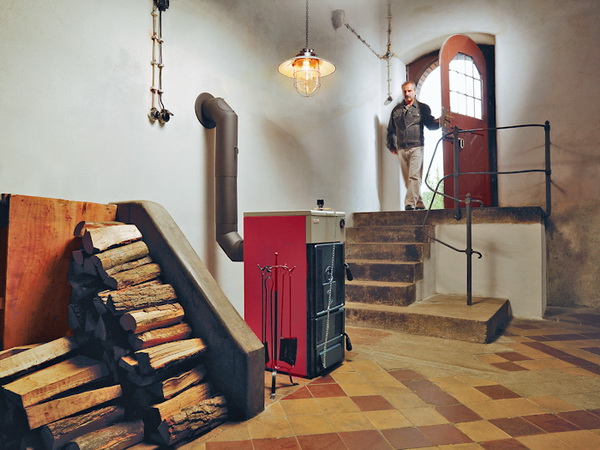
That is, even "enlightened Europe" heats their houses with wood, using wood-burning boilers for heating. Why don't we, in a country rich in forest resources, heat a private house with wood?
Despite the seeming simplicity of the issue, heating a private house with wood has several weighty "pitfalls":
- Firstly, firewood, like other energy sources, is becoming more expensive every year. And if in Siberia and the Urals you can get this type of fuel for the time being practically “for free”, then in the Moscow Region good dry birch firewood have long been worth from 2000 rubles per cubic meter.
- Secondly, firewood is not the most best fuel in terms of calories. Calorific value wood is much lower than other fuels. And some types of wood still have a calorific value 2 times lower than others - see.
- Thirdly, in direct-burning boilers and stoves, the laying of firewood burns out quite quickly and the owner of the house turns into a stoker, and heating with wood in a private house itself turns into a laborious process.
 Therefore, it is worth reading the forums and reviews of those who heat their home with wood to find out the following:
Therefore, it is worth reading the forums and reviews of those who heat their home with wood to find out the following:
- It is almost impossible to heat a private house with firewood when its area is more than 100 square meters. It is necessary to install either an ultra-long burning boiler of the Stropuva type, or install a good one.
- The firewood itself requires storage space, and you will also need to be physically fit to throw large amounts of firewood into the boiler when heating a large house.
- The solid propellant copper has big inertia. Once it is “fired up”, it will be difficult to stop the combustion process. What will happen in a closed heating system with circulation pump if , no need to tell.
Therefore, heating a private house with wood will be reasonable only in some cases.
When is heating a house with wood justified?
In order for the firebox process itself not to be a burden, for firewood to be a truly economical type of fuel, and not a "nightmare", it is worth understanding the following:
- You can heat a small house with wood. An area of 100-150 square meters is the critical limit for comfortable wood heating.
- It is unrealistic to heat a house with a “fire box”, which are modern stoves and simple direct combustion boilers.
- Heating a private house with wood should be built on the basis of a long-burning boiler, which uses the afterburning of pyrolysis gases, or has an adjustable firewood burning process.
- The boiler must be designed not only for burning dry standard firewood, but also for burning trimmings, slabs and other wood substandard.
Finding the perfect wood-fired boiler for home heating is difficult, but possible. It is worth taking a closer look at or trying to order the manufacture of a long-burning boiler by local craftsmen according to drawings from the forum.

Today we will consider heating system country house, options and prices for the purchase of equipment and installation of the entire system. For starters, let's just say...
When it is required to organize the heating of a country house, the heating options seem to be in plain sight - put the boiler and drown yourself. But,...
When it is possible to implement electric heating country house, the options can be very different. They differ not only in terms of...